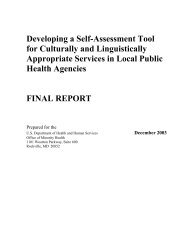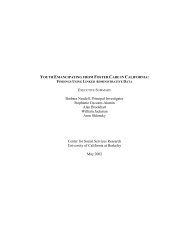Family Assessment in Child Welfare - Center for Social Services ...
Family Assessment in Child Welfare - Center for Social Services ...
Family Assessment in Child Welfare - Center for Social Services ...
You also want an ePaper? Increase the reach of your titles
YUMPU automatically turns print PDFs into web optimized ePapers that Google loves.
used. In the child welfare sett<strong>in</strong>g, the choice of method will also be governed by the follow<strong>in</strong>gpractical considerations (adapted from Johnson & Wells, 2000):1. Will the <strong>in</strong>strument be used <strong>for</strong> <strong>in</strong>itial assessment only or <strong>for</strong> the monitor<strong>in</strong>g of progress?If it is the latter, is the <strong>in</strong>strument sensitive to cl<strong>in</strong>ical change? Many <strong>in</strong>struments aredesigned to detect the existence of a given condition, not to measure improvement <strong>in</strong> a child orfamily’s function<strong>in</strong>g over time. Only <strong>in</strong>struments sensitive enough to detect client change canreliably measure it, a dist<strong>in</strong>ction that may not be apparent to many users. S<strong>in</strong>ce child welfaredecisions are often made when there appears to be a “lack of progress” on the part of a client,assessment <strong>in</strong>struments need to be very sensitive to measur<strong>in</strong>g change.2. What doma<strong>in</strong>s of family assessment are assessed? <strong>Family</strong> assessment <strong>in</strong>struments cover awide array of factors, from tangible outcomes such as the cleanl<strong>in</strong>ess of the home environment,to less tangible factors such as self-esteem. Be<strong>for</strong>e select<strong>in</strong>g measures, such as parentalfunction<strong>in</strong>g, parental behavioral health, or quality of the home environment, it is important <strong>for</strong>agencies and programs to clearly identify the goals and desired outcomes of services <strong>for</strong> childrenand families.3. How long does it take to adm<strong>in</strong>ister the <strong>in</strong>strument? <strong>Child</strong> welfare workers generally havelimited time to spend with clients. There<strong>for</strong>e, the time needed to adm<strong>in</strong>ister an assessment<strong>in</strong>strument needs to be brief. Managers will also want to consider the time it takes to tra<strong>in</strong>workers to use the <strong>in</strong>strument and the length of time required to <strong>in</strong>terpret the results.4. What is the developmental stage or age focus with respect to the <strong>in</strong>strument? The broadrange of ages of parents and children served by the child welfare system will require agencies toselect multiple <strong>in</strong>struments <strong>in</strong> most cases.5. Is it useful with the <strong>in</strong>tended target group of clients? For example, if an agency worksprimarily with Lat<strong>in</strong>o clients, know<strong>in</strong>g that a particular <strong>in</strong>strument has been tested with Lat<strong>in</strong>o<strong>in</strong>dividuals will be a def<strong>in</strong><strong>in</strong>g factor <strong>in</strong> selection. As most <strong>in</strong>struments have been normed withwhite English speak<strong>in</strong>g <strong>in</strong>dividuals <strong>in</strong> research sett<strong>in</strong>gs, serious consideration needs to be givento the appropriateness of us<strong>in</strong>g <strong>in</strong>struments <strong>in</strong> practice that are not culturally validated. Managerswill also need to consider how the <strong>in</strong>strument is adm<strong>in</strong>istered. If a client completes the <strong>for</strong>m, it isimportant to consider the read<strong>in</strong>g level of the <strong>in</strong>strument and the languages available.6. What are the advantages and disadvantages of us<strong>in</strong>g this <strong>in</strong>strument? Certa<strong>in</strong> cl<strong>in</strong>ical<strong>in</strong>struments have the advantage of assess<strong>in</strong>g a range of child or family function<strong>in</strong>g. Other<strong>in</strong>struments are useful <strong>in</strong> that they can be used along with other tools as part of a “package.” Anytime an <strong>in</strong>strument can provide <strong>in</strong><strong>for</strong>mation on multiple outcomes, managers are able to conserveresources. Several <strong>in</strong>struments may only tap one aspect of family function<strong>in</strong>g, or are useful onlywith a particular population. For example, some <strong>in</strong>struments may be written <strong>for</strong> a higher read<strong>in</strong>glevel than would be sensible <strong>for</strong> use with an agency’s client population. Managers andadm<strong>in</strong>istrators also need to consider the costs of purchas<strong>in</strong>g copyrighted materials or reproduc<strong>in</strong>gother <strong>in</strong>struments.6
















